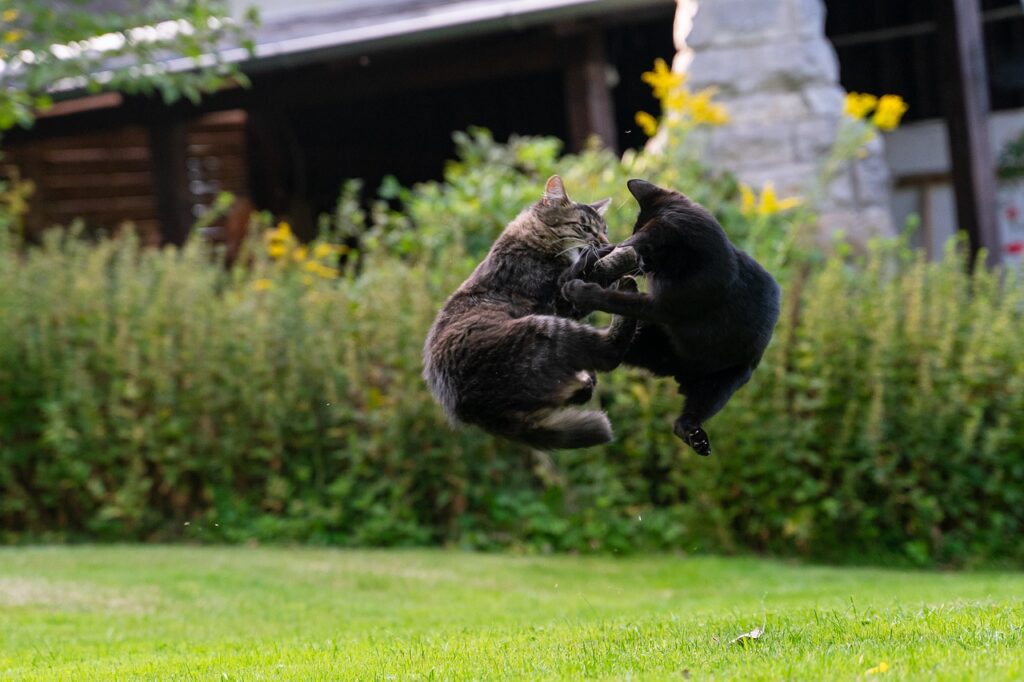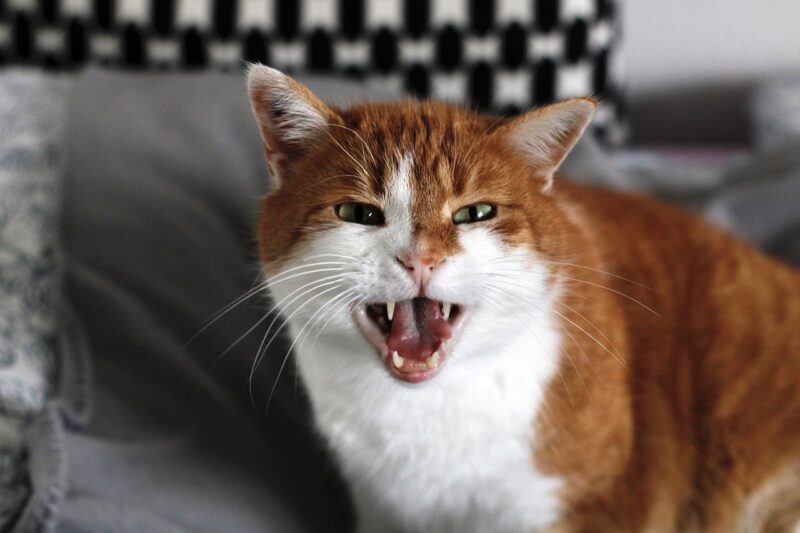Have you experienced petting your cat during a usual lazy day, then they suddenly biting and scratching your hand? Before you know it, your hand is already bleeding from its sudden attack. So, what happened, and what triggered this incident?
Turns out, aggression is common among cats, and this problem is actually the second most common reason why cat owners visit an animal behaviorist. A cat may become aggressive for several reasons, including fear, pain, dominance, and even too much petting.
Read on to know about understanding cat body language, when and why are they being aggressive, what to do during these times, and five helpful tips to make them calm.
What is aggression?
Aggression is a violent or threatening attitude towards another feline, other animals, and people. An aggressive cat is ready to attack anytime due to various circumstances that make them feel unsafe, stressed, frightened, angry, or frustrated.

Understanding a cat’s body language
Before cats launch into action, there are certain changes in the position of their body that will give you a sign that they are about to become aggressive.
It is important for owners to understand and read their body language so that they can better respond for next possible situations. Aside from body postures, facial expression will also help determine if a cat is ready to attack.
There are two kinds of aggressive cats: offensive and defensive. Offensive cats become aggressive because they want to pose dominance. Usually, these postures will make them look intimidating and larger than they are. Meanwhile, defensive cats display aggressive behavior to protect themselves. When they are in defensive mode, they try to make themselves look smaller.
Some of the offensive positions include:
- Raised hackles
- Stiff rear legs
- Hissing
- Growling or yowling
- Staring directly to the opponent with constricted pupils
- Upright ears that are slightly turned forward
- Crouching
- Whipping tail that is lowered down to the ground
On the other hand, defensive postures include:
- Dilated pupils
- Flattened ears that are turned backwards
- Raised hackles
- Crouching
- Head and tail tucked in
- Retracted whiskers for anxious cat
- Whiskers turned forward for frightened cats to estimate the distance between themselves and the opponent
- Facing sideways to the opponent
- Hissing with open mouth
- May tend to give quick attacks with claws out
Actual aggression, either defensive or offensive, includes:
- Biting
- Growling, yowling
- Scratching
- Hitting with paws
- Biting
If you see these signs, it means that it would be better not to interact with the cat since they are on the brink of attacking you at any time. Cats attack with impressive speed, and the damage caused by their sharp claws can be seriously painful.
Now that you’re familiar with cats’ different body languages, let’s head on to the heart of this article: the possible reasons behind a cat’s aggressive behavior.
Why is my cat aggressive all of a sudden?
There are many reasons for cat’s aggression. Knowing the cat’s history and location is a key component in knowing the cause of their aggressive behavior.
- Fear Aggression
The most common reason for a cat’s aggressiveness is fear. Some cats are born with “shy” genes, which means that they may easily get frightened thus being aggressive. Another reason for fear of aggression is poor socialization. If a cat does not know how to interact with people and animals, they grow to be fearful since everything is strangely dangerous. This gets worse if the owner uses harsh punishment, such as shouting and hitting.
Fear aggression may include a cat being aggressive to the presence of unfamiliar people and other animals, new environment, and certain noises.
- Pain-induced Aggression
It is common for cats in pain to display aggressive behavior. This is especially true for older cats who are already experiencing medical issues, including arthritis, traumatic history, infection, and dental problems among others.
When you touch a certain part of the cat’s body and they suddenly become aggressive, it must be because that area is painful. Aside from aggression, you may also notice the cat isolates himself from the family. In rare cases, some cats may still be aggressive even if the injured part is already fully healed.
- Territorial Aggression
Territorial aggression is triggered in cats when they feel that someone is invading their territory. Although territorial aggression is usually directed at cats, the presence of people and other animals may also provoke cats to be aggressive.
Because cats tend to defend their territory, they may try to chase away the individual by swatting or attacking. At some point, they may also attack returning resident cats if they’ve been away for quite a while.

- Status Aggression
Status aggression is similar to territorial aggression, but this is triggered when a cat wants to establish himself as the leader of the household. Signs of status aggression include blocking doors with their bodies and growling when you try to move them, swatting other cats, and even biting you when they see you spend time with another pet.
To deal with status aggression, it is best to completely ignore the cat while in aggressive mode. Once they are relaxed, you can reward them with treats and play sessions.
- Petting-induced Aggression
Petting-induced aggression happens when a cat is enjoying rubs and pets and they suddenly attack you. This happens presumably because of overstimulation where the petting session turns from pleasurable to annoying. This may also be triggered during a grooming session.
Signs of petting-induced aggression include stiff tails, ears moved backward, and dilated pupils. To avoid this type of aggression, you should stop petting them when they display any sign of aggression. Always allow a cooling period where there is no physical contact between you and your cat. Moreover, it is also worth noting not to hold them while they are eating.
When you know that a cat is displaying such a type of aggression, always make sure to supervise any interaction between that cat and children. This is because children often pet cats too much which may provoke cats to attack.
- Redirected Aggression
One of the most unpredictable types of cat aggression, redirected aggression happens when a cat is in a hyper-aroused mood due to external stimulus, including moving animals that they cannot chase outside, a terrifying or loud sound, or any reason for them to be excited but cannot respond quickly. If this type of aggression is triggered, you may unconsciously receive attacks from your cat out of nowhere.
- Maternal Aggression
As the name suggests, maternal aggression is triggered in queens who recently gave birth and are currently nursing their kittens. Queens may be aggressive to humans or animals who may try to approach them.
To prevent this type of aggression, you should provide the queen with a quiet and safe environment that has lesser traffic compared to other areas in the house to keep their stress at minimum. Usually, maternal aggression subsides once kittens mature.
- Predatory or play-related aggression
This type of aggression is commonly associated with cats that are weaned from their mothers at a very early age. These cats lack the experience and time to play with their mother and littermates, thus never learning the control or pressure of their bite.
What should I do if my cat displays sudden aggression?
When a cat shows aggression, simply observe the environment that may cause the trigger. In order to not escalate the situation, remove that stimulus that provokes them. If you think the cause of their aggression is out of your control, or if you cannot determine why they are aggressive in the first place, it is time to check with their veterinarian so they can examine your cat better.
8 ways to calm an aggressive cat
Cats that are displaying aggressive behavior should not end up in the shelter just because owners cannot handle them. Unfortunately, these types of occurrences happen most of the time.
To prevent these kinds of events, here are some tips you can do to calm an aggressive cat:
- Find the source of the aggression
Before taking an action, you need to know first the reason behind your cat’s aggressive behavior which was mentioned above. If you can eliminate the source, do it right away to prevent your cat from attacking further.
- Provide the cat with a safe place
According to animal behaviorists, aggression might be a sign that a cat is seeking help. It may be because they are stressed and would want an area to relax. Although cats get along with their family, they will still need some time for themselves, and you can do this by providing them with a special place, such as a cat condo.
- Supervise interactions between cats and children
As previously mentioned, cats, or any animal, should not be left with kids unsupervised. Although pets are loving to their families, there are specific actions that may trigger aggression in animals, including pinching, and ear and tail pulling. As for cats, animal behaviorists state that they are less tolerable of children compared to other animals.
- Don’t yell at the cat
Animals never respond to any negative kind of discipline, including yelling. To calm down an aggressive cat, ignoring them for a while might work until they calmed down. In addition, spending time with your cat strengthens the foundation of your relationship. Therefore, getting that trust and connection will make your cat feel that with you, they are safe and secured.
- Provide the cat with fun toys or activities
Usually, cat aggression is the result of lack of stimulation. By providing your cat with a fun environment, you are sure that all their energy is released, and therefore would eliminate fighting and aggression. Some of the items you can provide for your cat is cat condo, scratching posts, climbing perches, and most importantly, give your cat enough time to play with you.
- Interrupt fighting between cats
If you have multiple felines in the house, the possibility of fighting among felines is always there. This is especially true for cats that are not spayed. To prevent them from fighting each other, you can use a blanket or any item that can block eye contact between fighting cats. You can also whistle, call them, or shake their cat food container to distract them from fighting each other. However, it is not advisable to pick up an aggressive cat as they may attack you instead.
- Have them checked by the veterinarian
If all else fails, it is suggested to bring your cat to the veterinarian right away – especially for calm cats that suddenly turned aggressive. This is because sudden aggression may be because of pain from an underlying health issue that the veterinarian needs to detect.
- Use relaxing sprays or calming diffusers
If you search at your local pet store, or even online, there are various products that are designed to calm down cats. When a cat smells them, it makes them feel less anxious and aggressive since the scent that is released by the diffuser and spray mimics feline pheromones which reassures the cat to feel safer and more secure.
Read Also:
Adopting a new kitten: Male vs female kitten
Why do my cats meowing a lot?
Final Thoughts
Now that you know when and why your cat is suddenly being aggressive, it will help you determine what steps to take in the future so as not to ignite their aggression. Instead, understand that a cat will be aggressive for no reason, and can be attributed to one of the reasons mentioned above.
Fortunately, there are ways to help your cat calm down. However, the most vital factor is to make sure that you and your family build strong relationships with your cat. It is just as important that they are properly socialized so that they know how to act in different and unfamiliar situations. If these things are provided, your cat will be able to feel that they are safe and secured in your presence.
Sources and Further Reading
- https://avmajournals.avma.org/view/journals/javma/227/1/javma.2005.227.70.xml
- https://meridian.allenpress.com/jaaha/article-abstract/51/4/205/183314/2015-AAHA-Canine-and-Feline-Behavior-Management
- https://journals.sagepub.com/doi/abs/10.1016/j.jfms.2003.09.010
- https://journals.sagepub.com/doi/abs/10.1177/1098612X19831204
